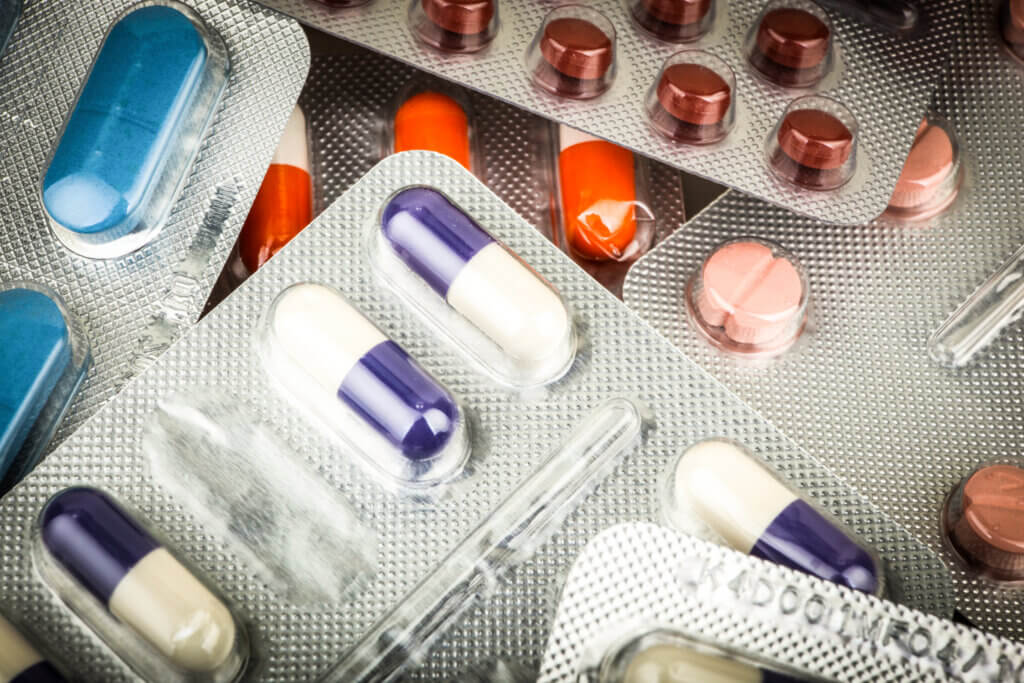The Effects of Mixing Alcoholic Beverages with Medications

Many medications include a warning in their package insert not to drink alcohol when taking the medication. Despite this, most people who consume alcohol also take medication, either occasionally or permanently. Mixing alcoholic beverages with medications isn’t something to be taken lightly, as the interactions can be potentially serious.
The list of drugs that interact with alcohol is very extensive. It includes both prescription-only and over-the-counter (OTC) medications. The interactions manifest in two ways: They can alter the metabolism of the drug or the metabolism of alcohol. Let’s see what you should know about it.
The consequences of mixing alcoholic beverages with medications
The consequences of mixing alcoholic beverages with medications are very varied. In principle, the effects depend on the specific type of drug.
Almost 500 medications can interact with alcohol, and they do so in a mild, moderate, or severe way according to each of them. Most interactions are moderate, although, under certain circumstances, they can be severe.
Although interactions under the spectrum of chronic alcohol consumption are often cited, the truth is that researchers warn about drug interactions derived from moderate alcohol consumption. That is, one or two drinks per day. Interactions can operate through four different pathways:
- Drinking alcohol can make certain medications less effective. This is because it interferes with the way they’re absorbed in the digestive tract.
- Drinking alcohol can raise the concentration of certain drugs in the blood. As a consequence, these can reach toxic levels.
- Drinking alcohol can worsen or exacerbate the side effects of certain medications.
- In the presence of some drugs, the characteristic effects of alcohol consumption can be prolonged. As we’ll see shortly, this can be potentially dangerous in certain circumstances.
When alcohol directly interferes with the normal metabolism of the drug, it’s said to be a pharmacokinetic interaction. Conversely, when alcohol alters the effects of the drug without changing the concentration of the drug in the blood, it’s said to be a pharmacodynamic interaction.
Drugs that interact with alcohol
As we’ve already stipulated, almost 500 drugs interact to some degree with alcohol. It would be impossible to name all of them in and the way in which they interact in this space, but we can analyze the most common ones. We’ll tell you about the most important interactions that you should know about.
Alcohol intake and antibiotics

Although it’s true that recent studies have questioned the interaction of alcohol with antibiotics, the truth is that its intake is contraindicated for many of them.
For example, erythromycin can increase the absorption of alcohol in the intestine, which in turn can speed up gastric emptying. Some anti-TB drugs, such as isoniazid, can cause liver damage when combined with alcohol.
Alcohol intake and antidepressants
All antidepressants available on the market today have some sedative and stimulant activity. We know that alcohol can boost these effects, as well as other complications such as memory impairment, unexpected disinhibition, violence, high blood pressure, and heart rhythm disturbances.
Tricyclic antidepressants (such as amitriptyline, doxepin, maprotiline, and others) and monoamine oxidase inhibitors (phenelzine, tranylcypromine, and others) are those that usually cause the greatest complications.
Alcohol intake and antihistamines
Experts point out that alcohol intake enhances the sedative effects of antihistamines. This can increase the risk of falls or affect the ability to drive or operate heavy machinery. While it’s true that second and third-generation drugs (such as loratadine, cetirizine, and others) are less sedating, they can still interact with alcohol.
Alcohol intake and hypnotics

We know that the combined intake of alcohol with sedative-hypnotic drugs, such as barbiturates, can increase the risk of oversedation and respiratory depression. It can also increase its side effects, as occurs for example with phenobarbital. Carrying out activities that require a certain degree of alertness can be potentially dangerous.
In addition to these, alcohol also interacts with muscle relaxants (carisoprodol, cyclobenzaprine, baclofen, and others), histamine H2 receptor antagonists (cimetidine, ranitidine, nizatidine, famotidine, and others), benzodiazepines, nonnarcotic analgesics, and pain relievers (NSAIDs, aspirin, and others), opioid analgesics (such as codeine, propoxyphene, oxycodone, and others), and blood thinners (warfarin); among many others.
Alcohol and drug interactions in older adults
Mixing alcoholic beverages with medications can be particularly counterproductive in older adults. On average, and as specialists warn, up to 9 out of 10 older adults take at least one medication permanently. More than half of these individuals drink alcohol regularly, so the risk of interactions is higher in this population.
As researchers point out, certain medications, when combined with alcohol, increase the risk of complications such as hypoglycemia, hypotension, sedation, gastrointestinal bleeding, and liver damage in older people. Simultaneous use of both isn’t something to be taken lightly, especially for those who drink alcohol moderately or heavily.
Because of this, it’s important for doctors to know how much alcohol their older patients drink. All this with the purpose of being able to effectively assess their risks, and advise them regarding the safe use of alcohol and medications. Patients, especially those who are under permanent treatment, should be aware of the interactions that their medications may have with alcohol intake.
Many medications include a warning in their package insert not to drink alcohol when taking the medication. Despite this, most people who consume alcohol also take medication, either occasionally or permanently. Mixing alcoholic beverages with medications isn’t something to be taken lightly, as the interactions can be potentially serious.
The list of drugs that interact with alcohol is very extensive. It includes both prescription-only and over-the-counter (OTC) medications. The interactions manifest in two ways: They can alter the metabolism of the drug or the metabolism of alcohol. Let’s see what you should know about it.
The consequences of mixing alcoholic beverages with medications
The consequences of mixing alcoholic beverages with medications are very varied. In principle, the effects depend on the specific type of drug.
Almost 500 medications can interact with alcohol, and they do so in a mild, moderate, or severe way according to each of them. Most interactions are moderate, although, under certain circumstances, they can be severe.
Although interactions under the spectrum of chronic alcohol consumption are often cited, the truth is that researchers warn about drug interactions derived from moderate alcohol consumption. That is, one or two drinks per day. Interactions can operate through four different pathways:
- Drinking alcohol can make certain medications less effective. This is because it interferes with the way they’re absorbed in the digestive tract.
- Drinking alcohol can raise the concentration of certain drugs in the blood. As a consequence, these can reach toxic levels.
- Drinking alcohol can worsen or exacerbate the side effects of certain medications.
- In the presence of some drugs, the characteristic effects of alcohol consumption can be prolonged. As we’ll see shortly, this can be potentially dangerous in certain circumstances.
When alcohol directly interferes with the normal metabolism of the drug, it’s said to be a pharmacokinetic interaction. Conversely, when alcohol alters the effects of the drug without changing the concentration of the drug in the blood, it’s said to be a pharmacodynamic interaction.
Drugs that interact with alcohol
As we’ve already stipulated, almost 500 drugs interact to some degree with alcohol. It would be impossible to name all of them in and the way in which they interact in this space, but we can analyze the most common ones. We’ll tell you about the most important interactions that you should know about.
Alcohol intake and antibiotics

Although it’s true that recent studies have questioned the interaction of alcohol with antibiotics, the truth is that its intake is contraindicated for many of them.
For example, erythromycin can increase the absorption of alcohol in the intestine, which in turn can speed up gastric emptying. Some anti-TB drugs, such as isoniazid, can cause liver damage when combined with alcohol.
Alcohol intake and antidepressants
All antidepressants available on the market today have some sedative and stimulant activity. We know that alcohol can boost these effects, as well as other complications such as memory impairment, unexpected disinhibition, violence, high blood pressure, and heart rhythm disturbances.
Tricyclic antidepressants (such as amitriptyline, doxepin, maprotiline, and others) and monoamine oxidase inhibitors (phenelzine, tranylcypromine, and others) are those that usually cause the greatest complications.
Alcohol intake and antihistamines
Experts point out that alcohol intake enhances the sedative effects of antihistamines. This can increase the risk of falls or affect the ability to drive or operate heavy machinery. While it’s true that second and third-generation drugs (such as loratadine, cetirizine, and others) are less sedating, they can still interact with alcohol.
Alcohol intake and hypnotics

We know that the combined intake of alcohol with sedative-hypnotic drugs, such as barbiturates, can increase the risk of oversedation and respiratory depression. It can also increase its side effects, as occurs for example with phenobarbital. Carrying out activities that require a certain degree of alertness can be potentially dangerous.
In addition to these, alcohol also interacts with muscle relaxants (carisoprodol, cyclobenzaprine, baclofen, and others), histamine H2 receptor antagonists (cimetidine, ranitidine, nizatidine, famotidine, and others), benzodiazepines, nonnarcotic analgesics, and pain relievers (NSAIDs, aspirin, and others), opioid analgesics (such as codeine, propoxyphene, oxycodone, and others), and blood thinners (warfarin); among many others.
Alcohol and drug interactions in older adults
Mixing alcoholic beverages with medications can be particularly counterproductive in older adults. On average, and as specialists warn, up to 9 out of 10 older adults take at least one medication permanently. More than half of these individuals drink alcohol regularly, so the risk of interactions is higher in this population.
As researchers point out, certain medications, when combined with alcohol, increase the risk of complications such as hypoglycemia, hypotension, sedation, gastrointestinal bleeding, and liver damage in older people. Simultaneous use of both isn’t something to be taken lightly, especially for those who drink alcohol moderately or heavily.
Because of this, it’s important for doctors to know how much alcohol their older patients drink. All this with the purpose of being able to effectively assess their risks, and advise them regarding the safe use of alcohol and medications. Patients, especially those who are under permanent treatment, should be aware of the interactions that their medications may have with alcohol intake.
- Holton AE, Gallagher P, Fahey T, Cousins G. Concurrent use of alcohol interactive medications and alcohol in older adults: a systematic review of prevalence and associated adverse outcomes. BMC Geriatr. 2017 Jul 17;17(1):148.
- Immonen S, Valvanne J, Pitkälä KH. The prevalence of potential alcohol-drug interactions in older adults. Scand J Prim Health Care. 2013 Jun;31(2):73-8.
- Menkes DB, Herxheimer A. Interaction between antidepressants and alcohol: signal amplification by multiple case reports. Int J Risk Saf Med. 2014;26(3):163-70.
- Mergenhagen KA, Wattengel BA, Skelly MK, Clark CM, Russo TA. Fact versus Fiction: a Review of the Evidence behind Alcohol and Antibiotic Interactions. Antimicrob Agents Chemother. 2020 Feb 21;64(3):e02167-19.
- Moore AA, Whiteman EJ, Ward KT. Risks of combined alcohol/medication use in older adults. Am J Geriatr Pharmacother. 2007 Mar;5(1):64-74.
- Saunders KW, Von Korff M, Campbell CI, Banta-Green CJ, Sullivan MD, Merrill JO, Weisner C. Concurrent use of alcohol and sedatives among persons prescribed chronic opioid therapy: prevalence and risk factors. J Pain. 2012 Mar;13(3):266-75.
- Weathermon R, Crabb DW. Alcohol and medication interactions. Alcohol Res Health. 1999;23(1):40-54.
- Zimatkin SM, Anichtchik OV. Alcohol-histamine interactions. Alcohol Alcohol. 1999 Mar-Apr;34(2):141-7.
Este texto se ofrece únicamente con propósitos informativos y no reemplaza la consulta con un profesional. Ante dudas, consulta a tu especialista.







